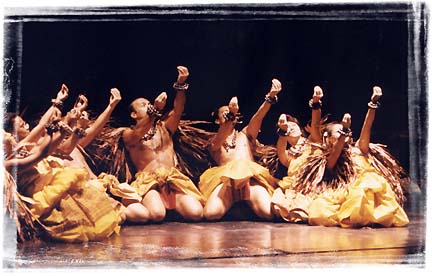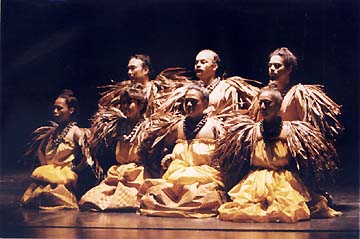Advertisement - Click to support our sponsors.

Top photo by Ken Sakamoto, Star-Bulletin
A family of dancers brings the
epic story of sisters Pele and Hi'iaka
to a national audienceStory of 'Holo Mai Pele'
By Suzanne Tswei
Star-BulletinLOPAKA Kanahele has known for at least three years -- because his grandmother, the hula legend Pualani Kanaka'ole Kanahele, had told him so -- that when he puts on his dancing costumes and steps on stage today, he'll be helping to set a new milestone in the tradition of hula.
Kanahele and the other performers in the family dance troupe, Halau O Kekuhi, will be dancing and chanting for "Great Performances," the Public Television series devoted to the best of the nation's performing arts. The hula will be broadcast as an hourlong special late next year, and it will be the first time the traditional Hawaiian art form is featured on the prestigious program.
His grandmother had sat him down to watch a couple of "Great Performances" shows and explained to him the importance of the program. But it was really the image of Julie Andrews, of "The Sound of Music" fame, that delivered the moment of revelation last week.
"Oh, wow, when I saw her, I just went: 'Wow, I know who she is. Our halau is going to be up there with her.' It was awesome," Kanahele said, recreating the shudder that ran through his body when he saw the halau being featured with Andrews and other notable artists in a promotional video for the television series' next season.

"As a performer, you can only dream about getting up there with people like Julie Andrews. But we see we are going to be on the same TV show and we don't have to go to New York to join a dance troupe to do it," Kanahele said.The pop icon had the same effects on some other members of the halau, said Kanahele's mother, Kekuhi, a leader of the halau that bears her name.
"I think some of the younger ones really didn't realize how important this is," she said. "They were not aware of the caliber of what we are doing. When they saw the lineup (for next season's shows), they were just beside themselves. Their jaws just dropped. Their eyes popped open. You see them swallow their spit."
Taping of the halau performing "Holo Mai Pele," based on the epic mythology of sister goddesses Pele and Hi'iaka, begins today at Neal Blaisdell Center concert hall. The performance is closed to the public.
Some changes will be made to accommodate the western television audience but without altering the essence of the dance, Kekuhi Kanahele said. Although Hawaiian tradition does not call for dancers to portray characters, the halau is making exception to that rule to help audiences better understand the story and the dance.

About five years ago Pacific Islanders in Communications, an organization aiming to bring Pacific Islanders' programming to national public television, began efforts to showcase the ground-breaking hula kahiko. Pualani Kanaka'ole Kanahele and her sister Nalani Kanaka'ole, daughters of revered kumu hula Edith Kanaka'ole, directed the three-hour hula in their unique style, hula aiha'a, a vigorous and demanding style of dancing that stays low to the ground."When we first saw the dance after it premiered in 1995, we were just floored. It was so powerful. We thought this would be perfect for 'Great Performances' -- a story about the Hawaiian culture, the Hawaiian people through dance and chants," said Executive Director Carlyn Tani. Public Television was immediately interested in the idea.
"Being on 'Great Performances' means that Hawaiian dance and chant will be getting the same attention as 'Swan Lake' and 'Madame Butterfly.'
" 'Holo Mai Pele' will be on the same level -- at the pinnacle of the performing arts," she said.
Sibling rivalry, a story as old as the tale of Cain and Abel, lies at the heart of the drama in "Holo Mai Pele." But it is at the same time the story of one individual's heroic awakening into selfhood. Story of ‘Holo Mai Pele’
The legend begins by introducing the two sisters, Pelehonuamea and Hi'iaka, whose family had migrated across the seas to dwell in the domain of the fiery volcano Kilauea on the island of Hawaii.
Pele, a proud, imperious beauty of great power, is the matriarch of the clan. Events are set in motion when Pele wishes to find her lover, Lohi'au, and commands her younger sister, Hi'iaka, to fetch him. Before she leaves on her errand, Hi'iaka is given the gift of hula, and she in turn entrusts to Pele the care of her beloved 'ohi'a groves. 'Ohi'a trees and their fragile, brilliantly colored flowers are emblematic of Hi'iaka.
The guileless younger sister sets out on her journey and battles, in succession, demons, death and the seduction of lust. She encounters relatives and others who, charmed by her innocence and character, reveal to her the genealogy of the Pele clan.
Hi'iaka grows in strength with each encounter and soon claims her full stature as a goddess -- she becomes one who takes and restores life. However, nothing can fully prepare her for the consequences of falling in love with Lohi'au.
Soon enough, Pele discovers the lovers, and in a fit of vengeance, destroys all things loved by Hi'iaka: She kills Lohi'au and burns her sister's 'ohi'a groves to the ground. Faced with this profound betrayal, Hi'iaka undergoes a painful loss of innocence. Yet, it is this very loss which ultimately frees the goddess to stand up and face Pele in battle.
The epic struggle of Pele and Hi'iaka is played out to this day in the ongoing tension and balance of natural forces. After each eruption, lava flows destroy what life lies in their paths, but before long, they become beds for 'ohi'a seedlings. In the Hawaiian cosmology, Pele and Hi'iaka make up the eternal cycle of destruction and renewal that drives creation.
Excerpt from television program proposal
by Pacific Islanders in Communications